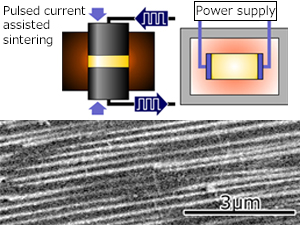Research
粒界制御されたセラミックスの高温変形および破壊
セラミックス、とりわけ高強度・高硬度を要求される構造セラミックスはいわゆる脆性材料であり、塑性変形能が極めて限られています。しかし、原子・イオン拡散が活発となる高温域であれば、塑性加工が可能になります。このとき、変形の主たる機構は粒界拡散クリープないし粒界すべりであり、粒界における物質輸送が変形および破壊挙動を決定する重要な因子となっています。我々の研究で、粒界近傍ナノメートルスケールでの化学組成や原子間相互作用が、構造セラミックスのマクロな高温変形および破壊と密接な関係があることが明らかになりました。我々は、セラミックスの高温変形および破壊について、粒界原子構造に基づくセラミックスの高温変形を自在に制御することを目指します。

強電界下セラミックス超塑性変形
構造セラミックスは脆性材料ですが、十分に結晶粒を微細化させると、粒界すべりを主体として百%以上の大きな塑性変形、いわゆる超塑性が起こり得ます。セラミックス超塑性は、難加工性であるセラミックス材料の新たな加工方法として注目されてきましたが、超塑性金属材料と比べて高温かつ低速度でしか加工できませんでした。ですが最近、構造セラミックスに強電界を印加することで、従来よりも数百°C低温かつ数十倍の高速でも超塑性変形が可能であることが我々の研究により明らかとなりました。我々は強電界印加によるセラミックス超塑性の促進について、そのメカニズムの究明と応用展開を目指して研究を進めています。
→プロジェクトのページへ

強電界下セラミックスの力学応答と物質移動現象
構造セラミックスの機械特性は、強電界の印加によって影響を受けることが分かってきました。例えば、強電界を印加すると、構造セラミックスを簡単に大きく曲げることができます。また、強電界によって導入される特有の点欠陥構造が、その起源に関わっていることを示唆する結果が我々の研究により見出されました。すなわち、強電界と点欠陥構造、また拡散や転位の運動などの物質輸送現象との相関を明らかにする必要があります。我々は構造セラミックスの力学応答に関する新たな学問を開拓すべく、各種機械特性とそれに関連する物質輸送現象における強電界の役割を解明する研究を進めています。
→プロジェクトのページへ

ユニークな異方性微細組織を使用したセラミックの機械特性の向上
Mg合金においてミルフィーユ構造の形成とそのキンク変形の導入により機械特性が向上することが指摘されています。高強度構造セラミックスで同様の機械特性向上が可能かどうか、興味が持たれます。そこで本研究では、フラッシュ焼結やパルス通電加圧焼結といった通電支援焼結技術を駆使し、酸化物構造セラミックスにおいて構成相や結晶方位、層間距離を高度に制御した微細な層状構造の創製に取り組むと共に、キンク帯形成の導入とその機械特性への影響の調査に取り組みます。
→プロジェクトのページへ

High temperature plastic flow and failure of grain boundary-controlled ceramics
Structural ceramics show excellent mechanical properties such as high strength and hardness, but are brittle materials with limited plastic deformability. However, plastic flow can take place at high temperatures where atomic/ionic diffusion is highly activated. The main mechanism of the plastic flow is grain boundary diffusional creep and/or grain boundary sliding, and mass transport at grain boundaries determines the deformation and fracture behavior. Our research revealed that the chemical composition and atomic interactions in the vicinity of grain boundaries with nano-scale are closely related to macroscopic high temperature deformation and fracture of structural ceramics. We study high temperature plastic flow and fracture of ceramics, focusing on grain boundary nanostructures, aiming to control high temperature plasticity of ceramics based on grain boundary atomic structure.

Superplastic flow of ceramics under applied strong electric fields
Structural ceramics are brittle materials with limited plastic deformability. However, if the grain sizes can be refined, large plastic deformation of more than 100%, i.e. superplasticity, can take place mainly due to grain boundary sliding mechanism. Superplasticity attracted attention as a new processing method for ceramic materials so far, but it could only be processed at a much higher temperature and a lower speed than superplastic metal and alloys. Recently, however, our research has revealed that superplastic deformation is attainable by applying a strong electric field at a temperature several hundred degrees lower and at a speed several tens of times higher than the conventional ones. We are investigating strong electric field-activated superplasticity in ceramics and developing its application.
→Link to current project

Mechanical response and mass transport phenomena of ceramics under strong electric fields
It has been found that the mechanical properties of structural ceramics are affected by the application of a strong electric field. For example, when a strong electric field is applied, structural ceramics can be bent easily and greatly. In addition, our research has found that the specific point defect structure introduced by the strong electric field is related to its origin. In other words, it is necessary to clarify the correlation between strong electric field and point defect structure, and mass transport phenomena such as diffusion and dislocation motion. We are conducting research to elucidate the role of strong electric fields in various mechanical properties and related mass transport phenomena in order to pioneer new studies on the mechanical response of structural ceramics.
→Link to current project

Improvement of mechanical properties of ceramics using unique anisotropic texture
It has been pointed out that the mechanical properties of Mg alloys are improved by the formation of a “millefeuille” structure and the introduction of kink band by warm working. Associated mechanism of the improvement of mechanical properties may work in high-strength structural ceramics. In this study, we use current-assisted sintering technology such as flash sintering and pulsed electric current sintering to produce fine layered structure with highly controlled constituent phases, crystal orientation, and interlayer distance in oxide structure ceramics. At the same time, we will work to introduce the formation of kink bands and investigate their impact on mechanical properties.
→Link to current project

